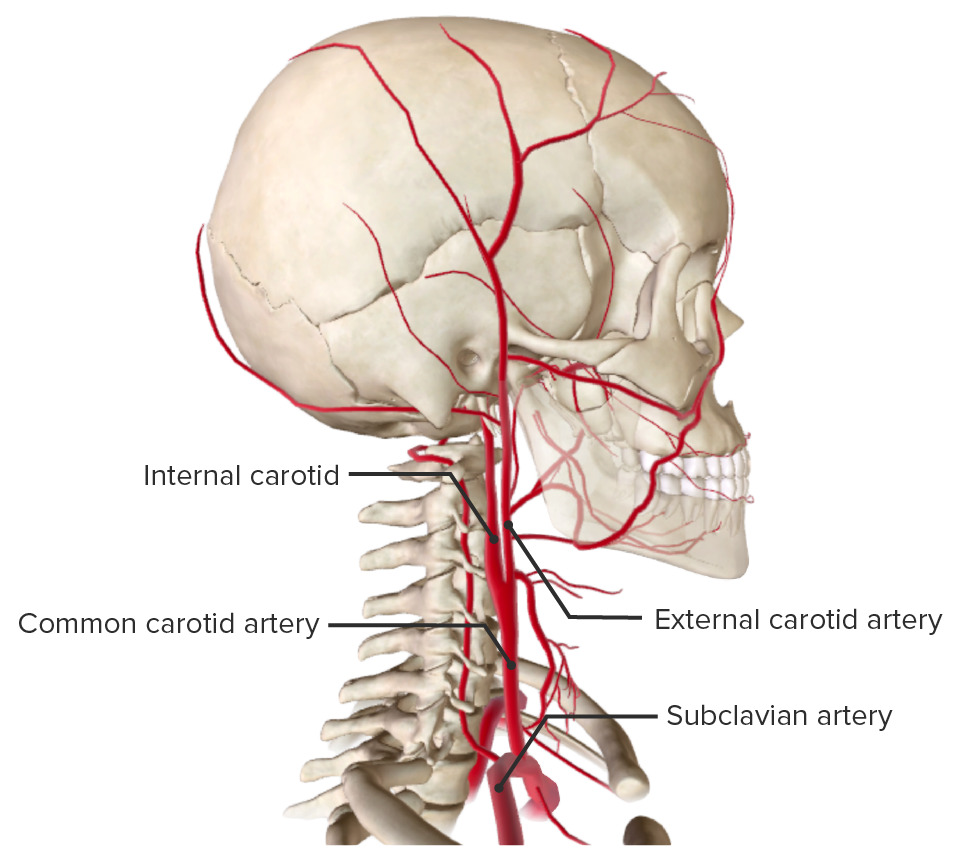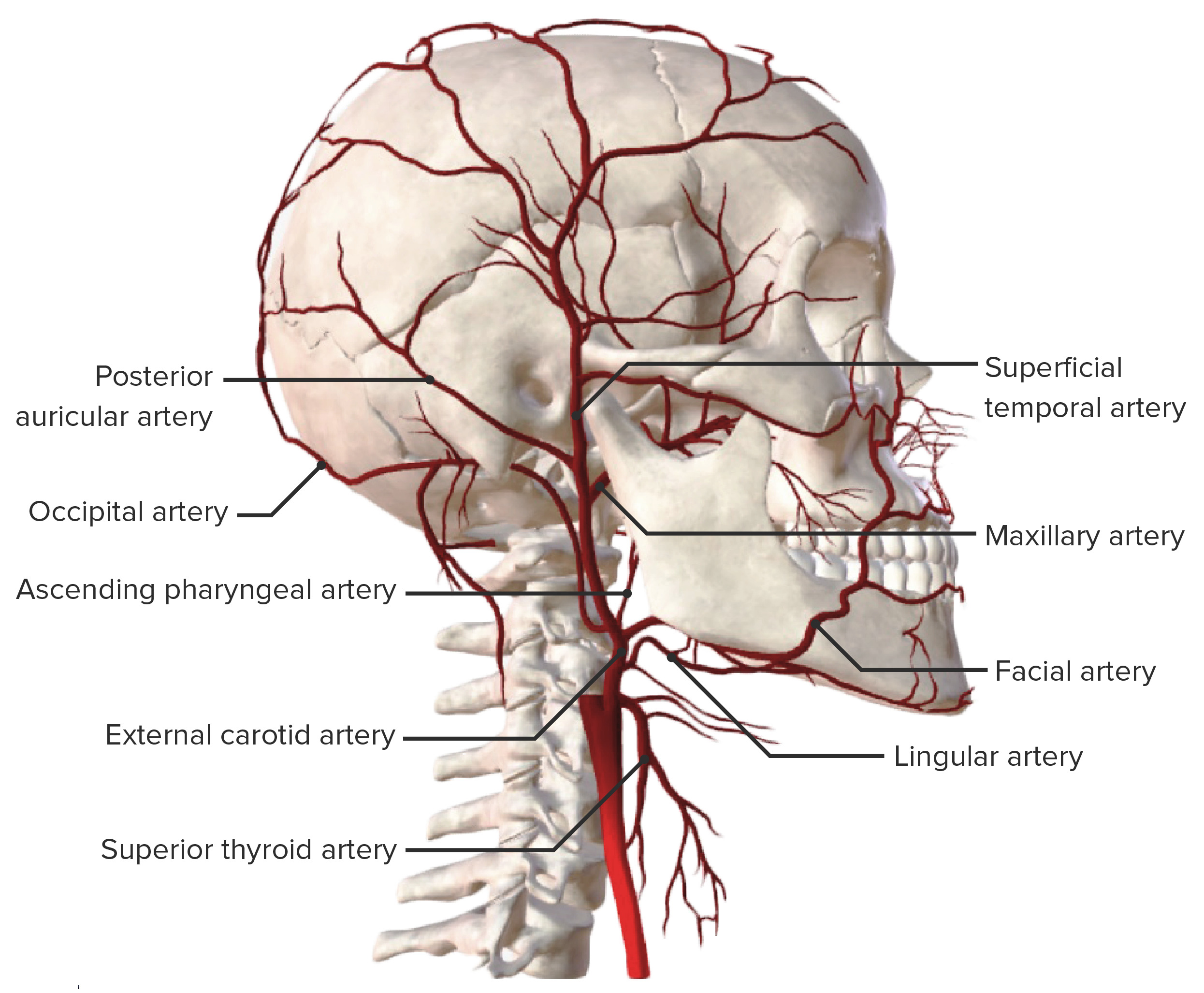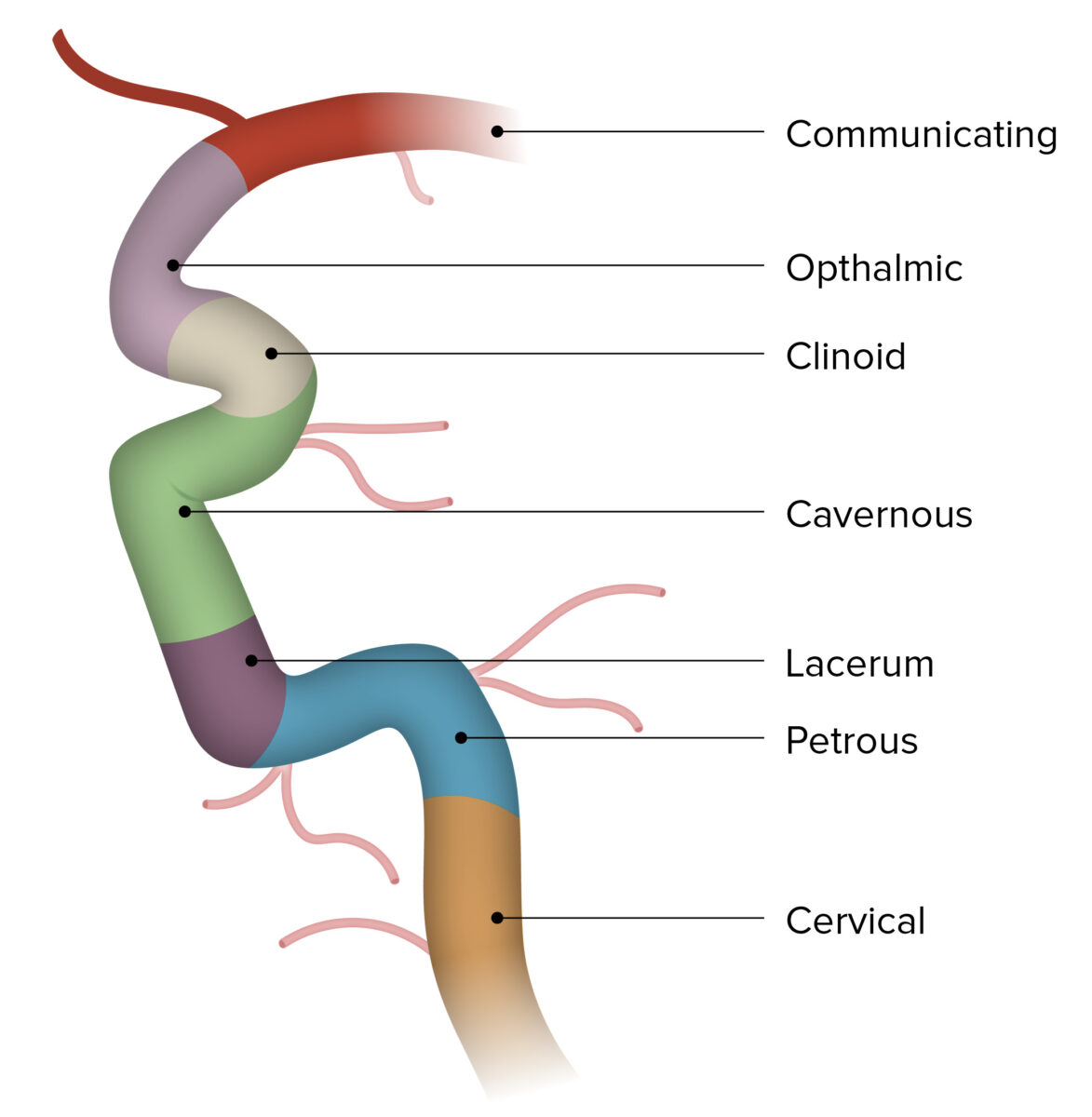The carotid arterial system provides blood supply to the head and neck Neck The part of a human or animal body connecting the head to the rest of the body. Peritonsillar Abscess. The arterial system begins as the common carotid artery, which arises directly from the aortic arch Aortic arch Mediastinum and Great Vessels: Anatomy on the left side and from the brachiocephalic trunk/artery on the right. The common carotid arteries Arteries Arteries are tubular collections of cells that transport oxygenated blood and nutrients from the heart to the tissues of the body. The blood passes through the arteries in order of decreasing luminal diameter, starting in the largest artery (the aorta) and ending in the small arterioles. Arteries are classified into 3 types: large elastic arteries, medium muscular arteries, and small arteries and arterioles. Arteries: Histology then ascend through the neck Neck The part of a human or animal body connecting the head to the rest of the body. Peritonsillar Abscess and divide into the internal and external carotid arteries Arteries Arteries are tubular collections of cells that transport oxygenated blood and nutrients from the heart to the tissues of the body. The blood passes through the arteries in order of decreasing luminal diameter, starting in the largest artery (the aorta) and ending in the small arterioles. Arteries are classified into 3 types: large elastic arteries, medium muscular arteries, and small arteries and arterioles. Arteries: Histology. The former supplies structures within the brain Brain The part of central nervous system that is contained within the skull (cranium). Arising from the neural tube, the embryonic brain is comprised of three major parts including prosencephalon (the forebrain); mesencephalon (the midbrain); and rhombencephalon (the hindbrain). The developed brain consists of cerebrum; cerebellum; and other structures in the brain stem. Nervous System: Anatomy, Structure, and Classification and orbits, whereas the latter supplies the superficial structures and parts of the neck Neck The part of a human or animal body connecting the head to the rest of the body. Peritonsillar Abscess and face.
Last updated: Dec 15, 2025
The common carotid artery has different origins on either side of the body:
The common carotid artery bifurcates at the level of the thyroid Thyroid The thyroid gland is one of the largest endocrine glands in the human body. The thyroid gland is a highly vascular, brownish-red gland located in the visceral compartment of the anterior region of the neck. Thyroid Gland: Anatomy cartilage Cartilage Cartilage is a type of connective tissue derived from embryonic mesenchyme that is responsible for structural support, resilience, and the smoothness of physical actions. Perichondrium (connective tissue membrane surrounding cartilage) compensates for the absence of vasculature in cartilage by providing nutrition and support. Cartilage: Histology (C4 vertebra) into:

Bifurcation of the carotid artery
Image by BioDigital, edited by LecturioCarotid body:
Carotid sinus:

Common carotid artery within the carotid sheath
Image by BioDigital, edited by Lecturio| Thoracic part Thoracic part Esophagus: Anatomy (left) | Lower neck Neck The part of a human or animal body connecting the head to the rest of the body. Peritonsillar Abscess (both) | Higher neck Neck The part of a human or animal body connecting the head to the rest of the body. Peritonsillar Abscess (both) | |
|---|---|---|---|
| Anterior |
|
|
|
| Posterior |
|
|
|
| Lateral |
|
|
|
| Medial | Brachiocephalic trunk/artery | Trachea Trachea The trachea is a tubular structure that forms part of the lower respiratory tract. The trachea is continuous superiorly with the larynx and inferiorly becomes the bronchial tree within the lungs. The trachea consists of a support frame of semicircular, or C-shaped, rings made out of hyaline cartilage and reinforced by collagenous connective tissue. Trachea: Anatomy |
|
The external carotid artery supplies the following structures:
Superficial, within the carotid triangle Carotid triangle Triangles of the Neck: Anatomy, and at the level of the thyroid Thyroid The thyroid gland is one of the largest endocrine glands in the human body. The thyroid gland is a highly vascular, brownish-red gland located in the visceral compartment of the anterior region of the neck. Thyroid Gland: Anatomy cartilage Cartilage Cartilage is a type of connective tissue derived from embryonic mesenchyme that is responsible for structural support, resilience, and the smoothness of physical actions. Perichondrium (connective tissue membrane surrounding cartilage) compensates for the absence of vasculature in cartilage by providing nutrition and support. Cartilage: Histology (C4)
To help remember the 8 major branches, use the following mnemonic: Some Anatomists Like Freaking Out Poor Medical Students.
| Branch | Structures supplied |
|---|---|
| Superior thyroid Thyroid The thyroid gland is one of the largest endocrine glands in the human body. The thyroid gland is a highly vascular, brownish-red gland located in the visceral compartment of the anterior region of the neck. Thyroid Gland: Anatomy |
|
| Ascending pharyngeal |
|
| Lingual |
|
| Facial |
|
| Occipital Occipital Part of the back and base of the cranium that encloses the foramen magnum. Skull: Anatomy | Posterior region of the scalp |
| Posterior auricular |
|
| Maxillary |
|
| Superficial temporal | Temporal region Temporal Region Epidural Hemorrhage of the scalp |

Major branches of the external carotid artery
Image by BioDigital, edited by LecturioThe internal carotid artery supplies the following structures:
The internal carotid artery is divided into segments:
Mnemonic: C‘mon Please Learn the Carotid Clinical Organizing Classification

Segments of the internal carotid artery
Image by BioDigital, edited by Lecturio